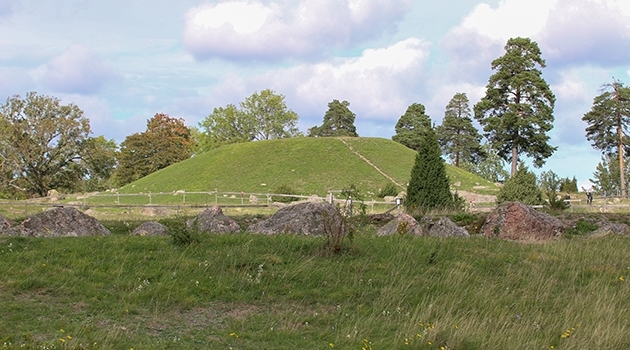New light cast on Scandinavia’s most important Bronze Age site
Håga, Scandinavia's most significant Bronze Age site, is relatively unknown. But in a new book, archaeologists at Uppsala University have brought together what is known and placed Håga in a larger context.
Håga is situated approximately three kilometres west of central Uppsala and is dominated by a large burial mound from the Bronze Age dating back to about 1000 BCE. Around the burial mound there are several burial grounds, cultic buildings and remnants of settlements from different epochs.
So far only a small portion of Håga has been excavated, although it is clear that Håga is the most significant Bronze Age site in Scandinavia. The largest excavation of the burial mound took place in 1902–1903, when more than a third of all gold discoveries from Sweden’s Bronze Age were found.
1902–1903 was led by Oscar Almgren. In the
photo Almgren stands in the middle of the mound
when it is being excavated. In 1914 Almgren
became the first Professor of Northern European
Archaeology at Uppsala University.
Photo: ATA (Antikvarisk-Topografiska Arkivet).
“Håga and the burial mound are not just any old place. This is an incredibly exclusive grave that points to what an important site Håga was during the Bronze Age,” says Anders Kaliff, Professor of Archaeology at Uppsala University.
Kaliff and Terje Østigård, Associate Professor in Archaeology, have written the book Bronze Age Håga and the Viking King Björn: A History of Interpretation and Documentation from AD 818 to 2018. The book translates to English for the first time documentation from the large 1902–1903 excavation of Håga Mound, also commonly known as King Björn’s Mound.
“Although Håga and Håga Mound are one of Scandinavia’s most significant Bronze Age sites, a methodical survey of the state of knowledge has been lacking, and much of the material has been available only in Swedish. In the book we review what we know about the site and put it into a larger international perspective, with a focus on sacrificial and burial rituals.”
Animal and human sacrifices
The way the grave was constructed points to remote contacts and influences from distant lands, including Denmark and Germany.
most spectacular findings of gold and bronze. The
gold double clasp in the photo is the most famous
discovery. The photo also shows a razor, sword,
buttons, rivets and tweezers.
Photo: Sören Hallgren ATA
(Antikvarisk-Topografiska Arkivet)
“A lot was happening on the Continent at this time, and the grave at Håga is unique for this part of Scandinavia. It is influenced by the burial customs on the Continent to a greater extent than those of the immediate surroundings.”
The burial mound is made up of different layers, with rituals performed at various levels. The body was first cremated; then the bones were buried in an oak chest in a burial chamber. Finally, the burial chamber was covered by soil, and at that stage animals and people were sacrificed. The burial mound contains the remains of at least three individuals who have been sacrificed as part of the burial ceremony.
Moreover, clear evidence of ritual cannibalism has been found in the form of a split femur from a woman with the same marks as the animal sacrifices.
“It’s one of the most discernible findings of ritual cannibalism that we have from Scandinavia.”
Håga’s strategic location
For 3,000 years Håga was a headland protruding into the sea, giving it a very strategic position.
“Håga was very centrally located. The main maritime route northward in the Baltic Sea went via Södertälje past Birka and Håga. People generally preferred to sail through Lake Mälaren rather than sail northward through the archipelago.”
About three kilometres south of Håga is Predikstolen, one of Uppland province’s largest ancient castles. The oldest phases of Predikstolen are about 200 years older than Håga Mound, but it was probably used while the mound was being built and also later.
stood one of Uppland province’s largest ancient
castles. The castle served as a lock securing the
water way northward in the Baltic Sea. The channel
passed below the cliff where there are woods in
the photo.
Photo: Anders Berndt
“The ancient castle served as a lock securing the water way that ran right next to the castle.”
Håga’s historical importance also is demonstrated through one of the oldest traces of iron production in Sweden, which has been unearthed at Håga.
“The remains date back to about 900 BC – in other words, quite a while before the Iron Age begins in earnest in Sweden.”
Håga has been a significant burial and ritual site over a long period, a significance that continues into the Viking Age and then was assumed by Gamla Uppsala. In Håga there are two cultic buildings, or cultic enclosures, as researchers prefer to call them. Cultic enclosures are symbolic buildings. There are no entrances. They are shaped like buildings, but researchers have not found any post holes for poles that can support a ceiling.
The large cultic building is contemporaneous with Håga Mound and had been in use for several hundred years. There is also a smaller, older cultic building from the early Bronze Age.
“It is clear that Håga as a cultic site served as a precursor to Gamla Uppsala that was emerging and becoming an important centre during the Viking Age.”
---
Find out more
The book Bronze Age Håga and the Viking King Björn: A History of Interpretation and Documentation from AD 818 to 2018 can be downloaded as a PDF file.
Anders Berndt

